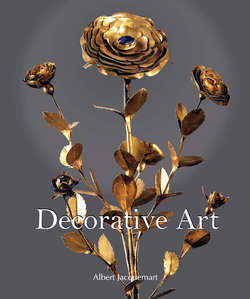Читать книгу Decorative Art - Albert Jacquemart - Страница 11
Furniture
Furniture panelled with plaques of porcelain
ОглавлениеAgain, there is no such thing as a perfect classification. Between the end of the reign of Louis XV and the beginning of that of Louis XVI there is certainly no marked transition; the sobered furniture in the Queen’s style is still seen with its chequered inlays and delicately chased bronzes. Louis XV, founder of the Porcelain Manufactory of France, no doubt caused Sèvres plaques with bouquets bordered with turquoise blue to be inlaid in the furniture he had around him or which he offered as gifts. And yet it is more particularly in the reign of Louis XVI and at the time when Amboyna wood and thorny spotted mahogany were replacing marquetry mosaics that porcelain and Wedgwood cameos were inlaid in panels, friezes and the drawers of furniture. It may be possible, therefore, to call the overlaying of furniture with porcelain by the name of the sovereign who so especially admired and patronised it.
In fact, the period of Louis XVI is that in which cabinet-making heavily employed its resources and multiplied its styles. Mahogany was in use from the time of Madame de Pompadour serving only as an additional auxiliary, which did not affect the marquetry trade. It was carried on, even in excess, during the reign of Louis XVI; the elegant secretaire belonging to Doctor Voillemol acts as proof with its subject’s medallions, arabesques, and flower clusters. Its minutely finished bronzes with gold gilding indicate the high rank this piece held in general production. At that time, not only were inlays and veneering used conjointly, but solid woods like ebony and mahogany were employed, along with panels of lacquer brought from the Far East. The true characteristics of the period must therefore be sought in the proper form and especially in the bronzes. We have already said how remarkable were those chased by Caffieri during the reign of Louis XV, but the end of the 18th century raised the art to its highest degree of perfection.
Here a rather singular observation presents itself; at the time when Madame de Pompadour was endeavouring to lead art back to a better track, it was in the name of the sacred and immutable principles consecrated by antiquity. During the reign of Louis XVI, when simplicity of form and sobriety of style were sought, it was still the antique that was to be attained. Unfortunately, nothing could be further removed from antiquity than the elegant coquetry and overcharged fastidiousness of the general decoration of the period, which was, however, to produce one genius, Clodion, who certainly had nothing in common with Greece and Rome. In the final days of the reign when clock-cases without form and rectangular commodes with engaged columns appeared less and less, the articles of furniture of rather melancholy contour, which were only worthy of remark from the manual perfection of their workmanship, still invoked an antique feel. Their main purpose, though, was to prepare the way for the false, stiff style which, through the instigation of David and aided by stiff palmettes and meagre foliage, constituted the Greek art of the first empire.
Where, then, can we find the true character of the Louis XVI’s style? In our opinion it is in those works which, being freed from all exaggeration of contour and redundancy of accessories, perfectly represent the French taste of the 18th century; that is, aristocratic elegance and grace without affectation. We discover these qualities in the work-tables, planters and consoles. The pier tables and armoire shelves supported by delicate feet with light flutings, adorned by matchless bronzes, modelled by artists of the first order who often inserted either the productions of Wedgwood or plaques painted with subjects from Sèvres, as well as simple bouquets of the same porcelain of embossed gold arabesques in relief on a royal blue, turquoise blue, rose Pompadour or partridge background. We find them again in candelabra stands with triangular bases, fluted stems, beaded or otherwise ornamented quills, all surmounted by a carved top, in short, in that infinity of articles which serve no real purpose except a pretext for displays of genius, wealth and good taste.
Venetian wardrobe, c. 1600. Painted wood, mother-of-pearl, and ivory, 96 cm. Castle of Écouen, Musée national de la Renaissance.
Game box, end of the 15th century. Ebony, painted walnut, and ivory, 39 × 24 cm (closed). Musée de Cluny, Paris.
Interior box of an ebony wardrobe, 17th century. Ebony, ivory, several varieties of wood, 50 cm. Castle of Écouen, Musée national de la Renaissance.
Cabinet, 16th century. Carved ebony, marquetry of several varieties of wood.
Cabinet, Paris, c. 1645. Ebony veneering on an oak and poplar frame, dark fruitwood base, 184 × 158.5 cm. Musée du Louvre, Paris.
Cabinet, Italy, 16th century. Red shell veneer and thin ivory lines. Blois Castle.
André-Charles Boulle (attribution), Chest. Copper, tin and shell veneering on a wooden core, bronze gilt, 86 × 148 cm. Musée du Louvre, Paris.
André-Charles Boulle (attribution), Writing desk, c. 1715. Bérain marquetry of copper on ebony base.
Mazarin desk with seven drawers, 17th century. Brass and red shell marquetry.
Léonard Boudin, Ogee-shaped writing desk, c. 1760. Rosewood marquetry.
